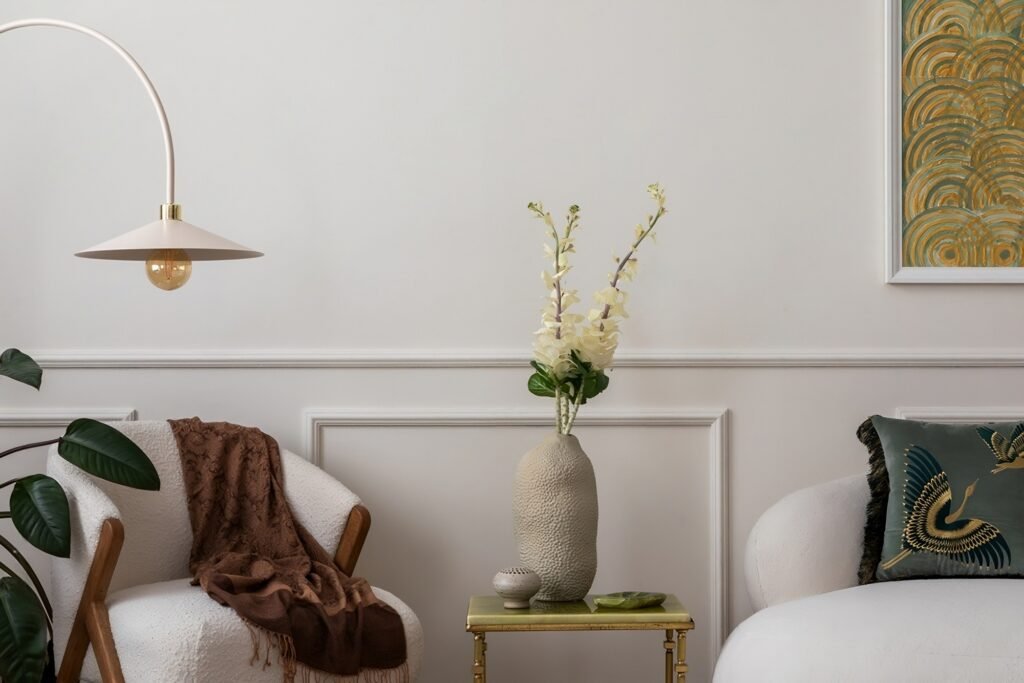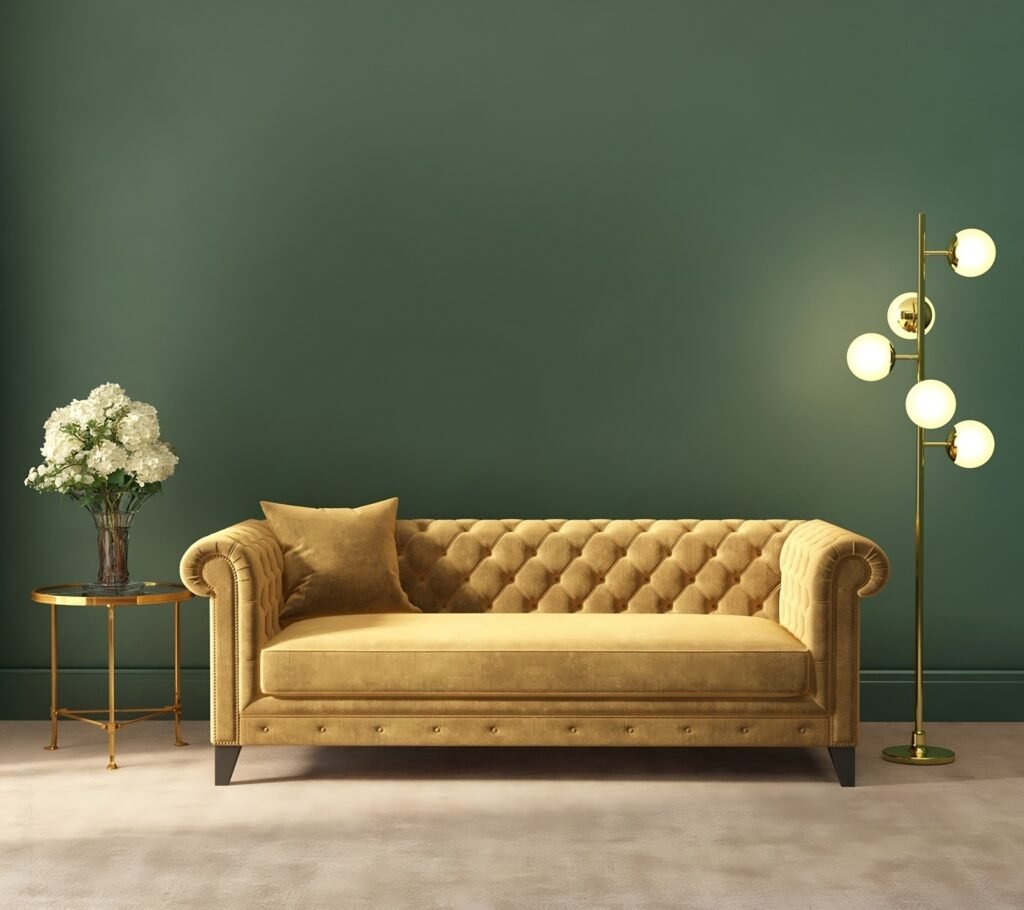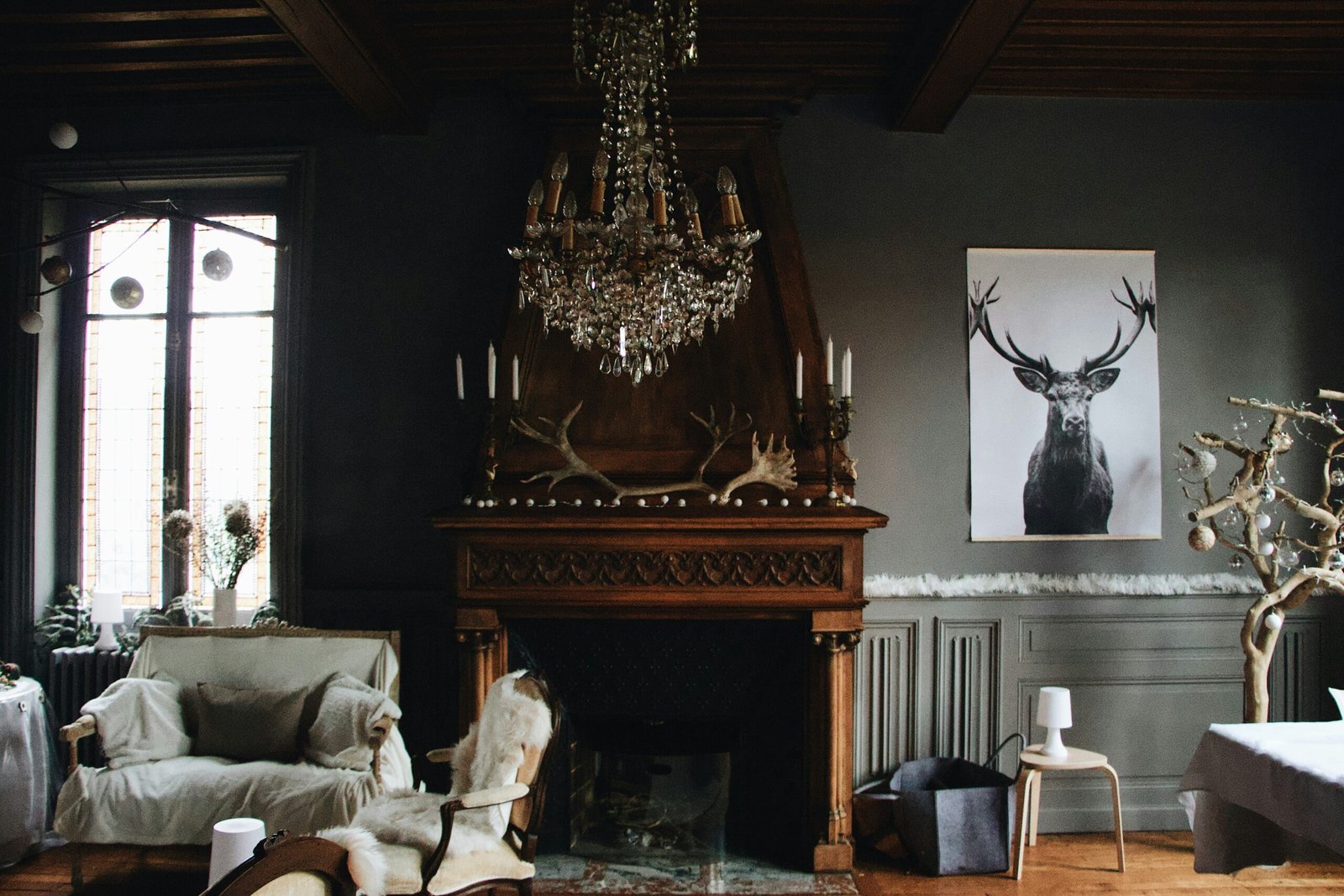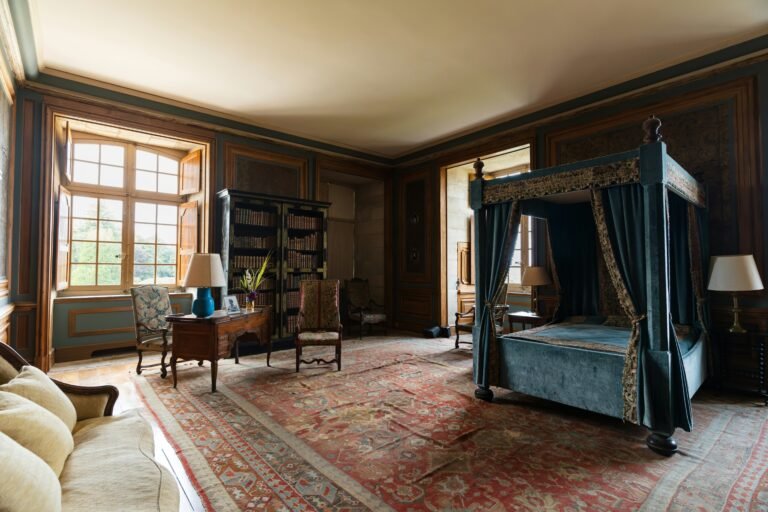Step into a world where bold geometry meets timeless elegance—this is the allure of Art Deco Interiors. From the glittering jazz age of the 1920s to today’s modern homes, the style has always carried an air of confidence, luxury, and glamour. What fascinates me most about this design approach is its ability to transform an ordinary room into a statement of artistry, without ever feeling outdated.
I still remember the first time I walked into a living space styled in Art Deco. The mix of polished brass accents, geometric patterns, and rich velvets instantly pulled me in—it felt both opulent and inviting. That is the magic of Art Deco: it’s more than a look, it’s an atmosphere. In this guide, I’ll walk you through how to bring that same sense of glamour geometry and luxury into your own home, blending history with modern practicality.
The Timeless Appeal of Art Deco Interiors
What makes Art Deco Interiors so enduring is their fascinating history and ability to adapt across decades. Born out of the optimism of the roaring 1920s, this design style first appeared at the Exposition Internationale des Arts Décoratifs et Industriels Modernes in Paris in 1925. According to Wikipedia’s history of Art Deco, the movement reflected a post-war hunger for progress, luxury, and modernism. Interiors from that era celebrated the future with clean lines, rich materials, and bold forms that symbolized prosperity.
Fast forward nearly a century, and the same visual language continues to resonate. Designers and homeowners today are drawn to Art Deco Design for its ability to bring glamour without being fussy. As Porter Magazine notes, this style remains one of the most influential movements in modern interior design because it strikes the perfect balance between sophistication and bold personality.
From Miami’s pastel-washed Art Deco hotels to New York’s iconic Chrysler Building, the visual cues of the movement remain unforgettable. But it’s not just about nostalgia. Contemporary homeowners are reinterpreting these motifs to fit modern living, choosing jewel-toned velvet sofas, geometric rugs, and sculptural lighting to create spaces that feel both glamorous and livable. As Interiyo highlights, the appeal lies in how easily Art Deco blends with current design trends, from minimalism to maximalism.
Personally, I find this timelessness deeply inspiring. Every time I see a sunburst mirror or a lacquered cabinet with brass trim, I’m reminded of how design can capture the spirit of an era while still feeling fresh. Art Deco isn’t just a passing trend, it’s a design philosophy that continues to celebrate glamour, geometry, and luxury in every detail.
Core Elements of Glamour Geometry
At the heart of Art Deco Interiors is a fearless embrace of geometry and opulence. The movement’s designers weren’t shy about making bold statements, and that’s exactly what keeps the style so magnetic today. Whether it’s a sweeping chevron-patterned floor or a lacquered cabinet with brass inlay, every element feels intentional, glamorous, and larger than life.
Geometric Patterns
One of the most recognizable hallmarks of Art Deco Design is its striking use of geometric patterns. Zigzags, sunbursts, chevrons, and stepped forms dominated architecture and interiors in the 1920s, often seen in everything from ceilings to rugs. As Kairos Interior explains, these motifs were meant to symbolize progress and optimism, echoing the machine age of their time.
Today, geometric wallpaper, tiled backsplashes, and patterned textiles remain powerful ways to introduce this aesthetic at home. I once added a sunburst-patterned rug to my living room, and it instantly anchored the space with a sense of energy and direction. The beauty of these patterns lies in their versatility, you can go bold with oversized chevrons or subtle with artful geometric trims.
Luxurious Materials
If geometry gives Art Deco its form, then materials bring it to life. This style is all about luxurious materials that exude richness. Think polished brass, chrome, marble, lacquered wood, and lush fabrics like velvet. According to House Beautiful, chrome accents remain especially popular today, offering a modern way to achieve that sleek Art Deco look.
Velvet sofas in jewel tones, marble coffee tables, or a brass chandelier can all infuse a space with a sense of grandeur. When I added a navy velvet armchair with gold trim to my study, it instantly felt more refined, almost as if the room demanded to be taken more seriously. The tactile richness of these materials isn’t just visual, it’s an immersive sensory experience that captures the glamour and luxury Art Deco is known for.
By combining daring patterns with sumptuous materials, Art Deco creates an environment where every surface and detail contributes to a sense of drama and sophistication.
How to Bring Art Deco Interiors into Your Home
The beauty of Art Deco Interiors is that you don’t need to live in a historic penthouse to enjoy their glamour. With the right choices in lighting, furniture, and color palette, you can capture the essence of this iconic style in any space.

Start with Statement Lighting
Lighting is often called the “jewelry of the home,” and nowhere is that more true than in Art Deco Design. Statement chandeliers, tiered glass pendants, and sculptural sconces are hallmarks of the style. According to Real Simple, sculptural fixtures are one of the easiest ways to bring personality into a room.
When I swapped a simple ceiling light for a brass and frosted glass Art Deco chandelier, the entire room transformed. It wasn’t just brighter, it felt like the centerpiece of the home. If you’re not ready for a full chandelier, even a pair of geometric wall sconces can set the mood.
➡️ More on this topic: How to Choose the Right Lighting Fixtures for Every Room in Your Home
Curate Furniture and Accessories
Furniture in Art Deco interiors is defined by bold silhouettes, glossy finishes, and intricate detailing. Mirrored surfaces, lacquered cabinets, and curved velvet sofas all speak the language of glamour decor. As Rowabi’s style guide points out, accessories like mirrored trays or brass-framed bar carts can be an accessible way to bring in the look.
I once introduced a black lacquer sideboard with chrome handles into my dining room. Beyond storage, it became a showpiece that reflected candlelight beautifully during dinner parties. It’s those kinds of details that elevate function into art.
Select a Color Palette
Color is where you can set the tone of your Art Deco interior. Jewel tones such as emerald, sapphire, and ruby are traditional, but you can also explore softer pastel interpretations inspired by Miami’s Art Deco district. Better Homes & Gardens suggests balancing bold colors with metallic accents to avoid overwhelming the space.
In my own home, I paired an emerald green sofa with brass lamps and cream walls. The jewel tone made a strong statement, while the metallics provided sparkle and the neutrals gave the eye a place to rest. The result felt glamorous yet balanced, exactly what Art Deco aims for.
Blending Contemporary with Art Deco
One of the reasons Art Deco Interiors have never truly gone out of style is their ability to evolve. While the original movement thrived on lavish ornamentation, today’s interiors often favor a more restrained approach. The key lies in blending the bold confidence of Art Deco Design with the clean lines of modern minimalism.
Finding the Balance
As Foyr’s design experts note, contemporary Art Deco often emphasizes geometry and luxury without overwhelming a space. Instead of filling a room with ornate detail, homeowners may choose one or two bold statements like a geometric backsplash, a jewel-toned sofa, or a brass-accented coffee table while keeping the rest of the palette simple.
I personally experienced this balance when I updated a small guest room. Rather than covering every wall in bold wallpaper, I opted for one accent wall with a repeating fan motif. Paired with minimalist furniture and a neutral rug, the pattern became a striking focal point without dominating the room.
Real World Inspiration
One stunning example comes from a Florida remodel featured in Livingetc. The designers used emerald tiles, a curved backsplash, and a brass hood in the kitchen, proving that Art Deco can feel fresh and functional in modern homes. It wasn’t about replicating the past but rather capturing its essence geometry, glamour, and rich materials within a contemporary framework.
Why It Works
This blended approach works because it lets you enjoy the drama of glamour decor while keeping the home practical for everyday life. Too much ornamentation can feel dated, but selective nods to the past allow you to honor Art Deco’s history while enjoying the best of modern design.
For me, this is the most exciting part of Art Deco today. It’s not about living in a museum, it’s about reinterpreting luxury and geometry in ways that feel authentic to your lifestyle.
➡️ More on this topic: Sustainable Home Decor: Eco-Friendly Choices for a Stylish Interior
Attention to Detail: Accessories and Finishes
In Art Deco Interiors, it’s often the finishing touches that elevate a room from ordinary to extraordinary. Accessories, trims, and surface details carry the spirit of the style just as much as furniture or color. When thoughtfully chosen, these accents bring a space together and amplify the sense of glamour.

Chrome and Metallic Accents
Metallic finishes are essential to the world of luxurious materials. Chrome, brass, and gold tones were signature features in 1920s and 1930s interiors. As House Beautiful explains, chrome remains one of the most versatile metals for modern homes, lending a sleek, futuristic edge while honoring Art Deco tradition. Even small touches like a chrome-framed mirror or brass lamp base can tie a room together.
When I added a chrome tray table to my living room, I was surprised by how much elegance it introduced. It reflected light beautifully and echoed the geometric rug beneath, creating cohesion without overpowering the space.
Decorative Glass and Crystal
Glasswork also played a defining role in Art Deco. The era celebrated innovation in decorative glass and crystal, particularly through designers like René Lalique. As The Times notes, Lalique’s creations turned glass into a symbol of glamour, with frosted textures, etched patterns, and dazzling clarity. Adding a statement glass vase, crystal sconce, or frosted panel can subtly echo this luxurious tradition.
Mirrors and Sunburst Motifs
No accessory screams Art Deco quite like a mirror. Sunburst mirrors, with their radiating frames, remain a timeless way to bring energy and visual drama into a room. I personally installed a large sunburst mirror above a console table, and it became the centerpiece of the entryway. Guests often comment on it before anything else, it sets the mood immediately.
These details, though small, carry immense weight in design. By layering metallics, glass, and iconic motifs, you can achieve that authentic glamour decor feel without needing to renovate an entire space.
Why This Style Works for Modern Homes
The enduring popularity of Art Deco Interiors comes down to more than nostalgia. At its core, the style reflects optimism, craftsmanship, and a love for beauty that still resonates today. It’s no surprise that homeowners and designers keep revisiting this aesthetic, adapting it to fit new lifestyles and spaces.
Optimism and Personality
Art Deco was born in a time of social and cultural transformation, embodying a spirit of hope and modernity. According to Interiyo, the style thrives on its ability to combine elegance with personality. In modern homes, this translates into interiors that feel confident and uplifting, a much-needed antidote to sterile, cookie-cutter spaces.
When I brought a jewel-toned velvet chair into my otherwise minimal living room, it instantly shifted the atmosphere. Suddenly, the space had character, almost like it was telling a story. That’s what I find most powerful about Art Deco Design, it injects personality without overwhelming.
Craftsmanship and Quality
Another reason Art Deco continues to shine is its emphasis on quality. From lacquered woodwork to hand-cut glass, the original movement celebrated craftsmanship. As Wikipedia notes, Art Deco was both modern and luxurious, merging machine-age efficiency with artisanal detail. Today, investing in well-made furniture or decor inspired by this tradition means creating interiors that last longer, both physically and aesthetically.
Function Meets Luxury
In contemporary design, function often takes precedence but that doesn’t mean luxury is out of reach. Art Deco finds the balance by offering practical furniture and layouts enhanced with rich materials and geometric flourishes. It’s an approach that allows a sofa to be both comfortable and glamorous, or a sideboard to be both useful and striking.
For modern homes, this balance is key. You don’t need an entire room dripping in ornamentation to enjoy the look. A handful of carefully chosen glamour decor details can elevate even the simplest apartment into something remarkable.
Conclusion
The enduring magic of Art Deco Interiors lies in their ability to merge glamour, geometry, and luxury in ways that feel both timeless and personal. From bold geometric patterns and sumptuous materials to statement lighting and mirrored finishes, every element contributes to an atmosphere of sophistication. What started as a symbol of progress and prosperity in the 1920s continues to inspire homeowners who want more than just functional spaces, they want rooms that tell a story.
For me, the true beauty of Art Deco is how adaptable it is. I’ve seen it shine in grand living rooms as well as in modest apartments, proving that it’s less about size and more about intention. A single velvet chair, a sunburst mirror, or a brass chandelier can be enough to capture its spirit.
I hope this guide inspires you to experiment with your own interiors, layering geometry, materials, and accessories to create a space that reflects your personality. With Art Deco, you’re not just decorating, you’re curating a lifestyle of elegance, optimism, and lasting beauty.
Frequently Asked Questions about Art Deco Interiors
Alex is the creator of Homely Haven, a space dedicated to simple, stylish ideas for interiors and gardens alike. With a passion for cozy living rooms, inviting outdoor spaces, and practical DIY solutions, Alex shares tips and guides that help turn any house into a true home.
From budget-friendly decorating hacks to weekend garden projects, the goal is always the same: to inspire you to create spaces that feel personal, beautiful, and welcoming. When not writing, Alex is usually rearranging furniture, sketching new garden layouts, or exploring design trends for the next project.








